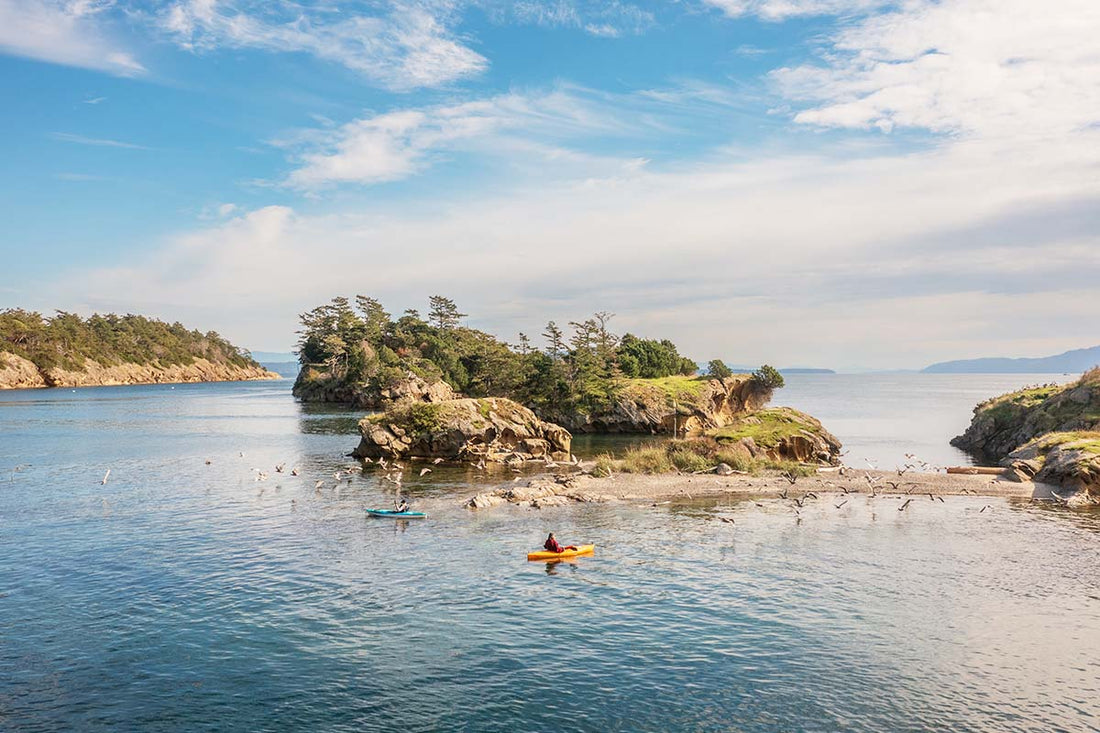
Kayak Camping in the San Juan Islands: PNW Island-Hopping by Paddle
Share
Kayak Camping in the San Juan Islands: PNW Island-Hopping by Paddle
Plan your San Juan Islands kayak camping trip. Discover routes, tide tips, wildlife encounters, and the essential gear for multi-day paddling in Washington’s coastal waters.
Why the San Juan Islands Are a Kayaker’s Dream
Off Washington’s northwest coast, the San Juan Islands are a protected maze of channels, inlets, and pocket coves. The scenery shifts with every stroke—from kelp beds alive with seals to rocky headlands topped with madrona trees.
With dozens of marine state parks offering kayak-in campsites, it’s one of the few places you can load your boat, paddle into the horizon, and sleep under the stars on a different island each night.
The Island-Hopping Experience
Kayak camping here isn’t just about paddling distance—it’s about reading tides, catching slack current, and finding the right campsite before the wind picks up. Popular launch points include Friday Harbor, Shaw Island, and Anacortes, with routes linking spectacular paddling spots like:
Jones Island Marine State Park – Sheltered coves, forested camps, and tame deer greeting you on shore. Expect 24 primitive campsites and can’t-miss sunset views.
Stuart Island Marine State Park – A longer paddle rewarded with quiet harbors, short hiking trails, and a peaceful, marine-wildlife–rich shoreline.
Sucia Island Marine State Park – The crown jewel for paddlers—rugged sandstone shores, hidden tide‑pool coves, and multiple campsites make it perfect for a multi-night base or a pivotal stop in your loop.
Turn Island Marine State Park – A small, calm island just off Friday Harbor—great for a first or last night, with twelve covered primitive campsites within paddling distance of town.
When to Go
Late summer—August into early September—offers the warmest water and most reliable weather. Mornings tend to be calm, with winds building in the afternoon. Always plan crossings early in the day and build in buffer time.
Wildlife Encounters
The San Juans are home to orcas, porpoises, seals, sea lions, eagles, and countless seabirds. Follow the Be Whale Wise guidelines—keep 300 yards from orcas, and never paddle directly toward wildlife. The magic is in seeing them in their own rhythm, not yours.
Essential Gear for San Juan Islands Kayak Camping
When you're heading into salt-sprayed crossings and island camps, field-tested gear makes all the difference:
Sherpak™ Boat Roller – Solo loading made simple. The heavy-duty suction cups and adjustable angles make lifting a fully loaded kayak onto your vehicle effortless even after a long paddle.
DriLite™ Jetty Dry Sacks – Flat-seam design lets these bags slip easily into kayak hatches or strap to decks. Keep your sleeping gear dry—even if the spray finds its way onboard.
E‑Merse™ Waterproof Cases – Tough, touch-screen–friendly, and fully submersible. Perfect for keeping your charts, tide apps, and priorities dry and easy to access.
Pocket Sink / Pocket Bowl – Lightweight and collapsible, these workhorses carry water for dishes or rinsing gear when fresh water isn’t nearby. Built tough with welded seams and ripstop nylon.
Trip Planning Tips
Tide & Current Charts: These waters have some of the strongest currents in the lower 48. Plan your route with tides in mind, especially for exposed crossings like San Juan Channel or Haro Strait.
Permits: Marine state park campsites are first-come, first-served. Have a backup plan.
Safety: Always carry a marine VHF radio for weather and emergency communication—cell coverage is patchy.
Why the San Juans Will Keep You Coming Back
No two trips are the same here. One day you’re gliding past a seal haul-out in glassy water; the next you’re tucking into a kelp bed to rest from the tide. The mix of wildlife, quiet campsites, and challenging-but-manageable navigation makes the San Juans a top-tier kayak camping destination.
Pack right, respect the water, and you’ll understand why paddlers return here year after year.